

The exhibit, Layers of Place is a curated collection of seven location-based AR experiences encouraging exploration of often unseen dimensions of MIT’s public spaces—uncovering layers of history from forgotten pasts to overlooked presents and speculative futures.
Through this collective exploration, the campus transforms into a platform for multidimensional, pluralistic inquiry, delving into themes such as racial justice, historical memory, monuments, environmental stewardship, and the impact of technology on civic life. The importance of plurality is central, presenting seven perspectives on different concepts and viewpoints. In a world that is increasingly polarized and lacking in nuanced perspectives, Layers of Place emphasizes the communal experience. By expanding “public space” to include both the tangible campus environment and the virtual layers accessible through AR, we create a new form of communal experience.
 Humble Monuments is a participatory, multi-layered project that illuminates the fragile, poetic entanglements between humans and the natural world, using AR interventions at the sites of MIT’s current and former pocket parks and community gardens. While MIT features many such small gardens, they remain empty of the traces of particular human relationships and emotional investments one encounters in a lived-with and loved tangle of plants, whether these exist on a windowsill, a backyard, a community garden plot, or a carefully stewarded natural sanctuary. This project reimagines several key areas on the MIT pocket park map as virtual gardens, integrating 3D captures of these personal plots, intimate memories, and MIT archives of endangered and lost local species. By doing so, it bridges the gap between what is present, what is absent, what has been lost, and what is at risk of disappearing.
Humble Monuments is a participatory, multi-layered project that illuminates the fragile, poetic entanglements between humans and the natural world, using AR interventions at the sites of MIT’s current and former pocket parks and community gardens. While MIT features many such small gardens, they remain empty of the traces of particular human relationships and emotional investments one encounters in a lived-with and loved tangle of plants, whether these exist on a windowsill, a backyard, a community garden plot, or a carefully stewarded natural sanctuary. This project reimagines several key areas on the MIT pocket park map as virtual gardens, integrating 3D captures of these personal plots, intimate memories, and MIT archives of endangered and lost local species. By doing so, it bridges the gap between what is present, what is absent, what has been lost, and what is at risk of disappearing.Through a collaborative, co-creative approach, we will collect audio stories from MIT community members about the personal “gardens” they are entangled with. Participants are invited to contribute “digital twins” of these, captured through a simple process by themselves or by our team. These Humble Monuments will then be curated into clusters of plants, archival materials and audio stories, and digitally “planted” in AR across current and former public park and garden sites on the MIT campus. This co-creation process will begin in the months prior to the festival, and continue through public workshops during the festival. Visitors to one of the sites augmented by the project will use their phones as “portals” to explore the virtual garden cluster overlaid on it on a human scale. They’ll be able to wander within the virtual plants, listen to intimate stories and encounter within them echoes of birds, insects and other endangered species introduced from MIT’s archives. These virtual gardens invite visitors on a journey between real and imagined landscapes, encountering Humble Monuments.
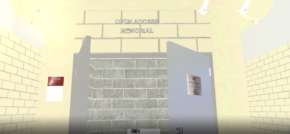 Open Access Memorial is an Augmented Reality experience dedicated to Aaron Swartz, an internet pioneer who cofounded Reddit and played key roles in the development of Creative Commons, RSS, and RDF, among other notable achievements. Swartz also brought millions of U.S. District Court records out from behind PACER’s “pay wall”, which were full of privacy violations.
Open Access Memorial is an Augmented Reality experience dedicated to Aaron Swartz, an internet pioneer who cofounded Reddit and played key roles in the development of Creative Commons, RSS, and RDF, among other notable achievements. Swartz also brought millions of U.S. District Court records out from behind PACER’s “pay wall”, which were full of privacy violations.On January 6, 2011, Swartz was arrested by the MIT Police and an agent of the U.S. Secret Service. He was accused initially of breaking and entering with the intent to commit a felony: downloading a large number of academic articles from JSTOR. In the words of Lawrence Lessig, the Roy L. Furman Professor of Law and Leadership at Harvard Law School, “[JSTOR] declined to pursue their own action against Aaron, and they asked the government to drop its. MIT, to its great shame, was not as clear, and so the prosecutor had the excuse he needed to continue his war against the “criminal” who we who loved him knew as Aaron”. The prosecution came to an end with Aaron’s premature death in January 2013.
The AR Open Access Memorial shows the exterior and interior of the (originally unlocked) wiring and telephony closet where Aaron Swartz’s computer was found. The closet is known as 16-004t, and is located in the basement of Building 16.
Instead of cables, boxes and racks, there is just a book plinth in the closet, displaying the 2 pages of the Guerilla Open Access Manifesto, written by Swartz in 2008, and depicting an image of Aaron sitting on a tree. The Guerrilla Open Access Manifesto is a call to action, advocating for open access to academic research, particularly to articles and papers that are often hidden behind expensive paywalls. Swartz believed that the scholarly knowledge produced by academics, often funded by taxpayers, should be freely accessible to everyone, not locked behind costly subscription fees or pay-per-article systems.
In addition to reading Swartz’s Manifesto, the users of this experience can also explore the corridors and find a hidden surprise. The python code written by Swartz to download the JSTOR articles (called keepgrabbing.py) has been put in the wall behind the closet, establishing a direct dialogue between the Guerilla Open Access Manifesto and the code used to activate and execute his principles. This correlation of natural language and code can be seen in poetic terms. Aaron’s document is more than an invitation, it is an exercise of critical thinking against a system of control that puts knowledge in a prison. His manifesto and the code are two sides of the same coin that shed light on the life of Aaron, as well as the significance of the location in the Dorrance Building (16).
The building was named after John Thompson Dorrance, who invented a method to create condensed soup, and was president of the Campbell Soup Company. Since 1991, the lobby of the Dorrance Building has been a prime spot to place MIT’s indoor hacks.
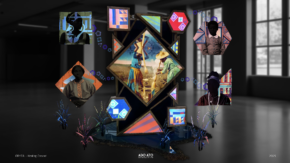 ORYZA is an interactive sculptural installation in the form of a quilt, symbolizing the thousands of Black agricultural scientists who were forcibly brought to the Americas and whose contributions were systematically erased through colonialism and slavery. By combining augmented reality (AR) and AI-enhanced storytelling, ORYZA unearths a hidden legacy of Black farmers in the U.S. and their vital contributions to agricultural technology—knowledge lost to history through both human and technological erasure.
ORYZA is an interactive sculptural installation in the form of a quilt, symbolizing the thousands of Black agricultural scientists who were forcibly brought to the Americas and whose contributions were systematically erased through colonialism and slavery. By combining augmented reality (AR) and AI-enhanced storytelling, ORYZA unearths a hidden legacy of Black farmers in the U.S. and their vital contributions to agricultural technology—knowledge lost to history through both human and technological erasure.In collaboration with the MIT Food and Agriculture Club (FAC), we aim to expand the conversation around sustainable agriculture, land justice, and the erasure of history through technological processes. ORYZA invites the MIT community to engage in critical dialogues about how technology, including AI, can perpetuate historical omissions, while also offering new opportunities for reclamation and healing.
The installation features a towering bronze sculpture, adorned with holographic textile panels that symbolize the enduring legacy of Black land stewards. Using AR, visitors can scan motifs on the sculpture to access an interactive archive, revealing the narratives and symbols woven into the installation. By blending physical and digital experiences, ORYZA highlights the agricultural legacy of the African diaspora and raises essential questions about the role of technology in remembering and rewriting history
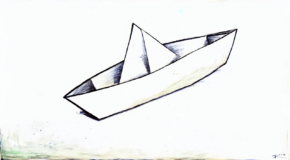 Paper Boat is an AR game/interactive experience that draws the passerby’s attention to the impact of global warming and the rising sea level at the MIT campus. Using the elements of play, animation, and performance, we want to provoke dialogue and bring awareness to the impact of the climate crisis and sea level rise at MIT, which will be directly impacted by global warming and is predicted to go underwater not too far in the future. One of the main issues we face in society in this regard is that we can’t directly see what is happening around us or envision the pace of climate change in our daily lives. This audiovisual interactive AR project will visualize and bring to the surface the exceedingly fast-paced melting glaciers, rising average temperature, and other global warming data for the campus communities and visitors. We intend to collaborate with MIT climate scientists to obtain precise data.
Paper Boat is an AR game/interactive experience that draws the passerby’s attention to the impact of global warming and the rising sea level at the MIT campus. Using the elements of play, animation, and performance, we want to provoke dialogue and bring awareness to the impact of the climate crisis and sea level rise at MIT, which will be directly impacted by global warming and is predicted to go underwater not too far in the future. One of the main issues we face in society in this regard is that we can’t directly see what is happening around us or envision the pace of climate change in our daily lives. This audiovisual interactive AR project will visualize and bring to the surface the exceedingly fast-paced melting glaciers, rising average temperature, and other global warming data for the campus communities and visitors. We intend to collaborate with MIT climate scientists to obtain precise data. In this interactive AR game/experience, the player will have to rescue an AR human character (silhouette man) riding on a paper boat. The game begins with a participant scanning a QR code next to specific manhole covers on campus, with virtual water coming out and occupying the space and a character and boat emerging on the surface.
To this end, the project uses the MIT manhole covers located near the Charles River and beyond, potentially any manhole cover anywhere in the world located close to sea level in areas near the seashore, as a narrative thread to visualize in real-time the rise in water levels over the next 150 years, by using augmented reality on an accessible smartphone. This work is a performative exercise in visualizing an inevitable catastrophe that is yet to come.
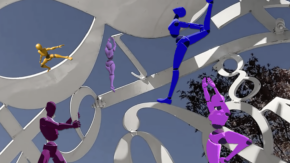 How do we remember the place of the self, the landscape of the mind, by moving inside them? Moving Memory uses AR to enhance the way that Jaume Plensa’s sculpture Alchemist invites you to contemplate what it means to be you, offering an enclosure that is both interior and exterior, public and private, calling attention to embodied subjectivity while being inside a person comprised of numbers and symbols that refer to objective methods of quantifying experience.
How do we remember the place of the self, the landscape of the mind, by moving inside them? Moving Memory uses AR to enhance the way that Jaume Plensa’s sculpture Alchemist invites you to contemplate what it means to be you, offering an enclosure that is both interior and exterior, public and private, calling attention to embodied subjectivity while being inside a person comprised of numbers and symbols that refer to objective methods of quantifying experience. When you step into Alchemist and begin the AR experience, you hear music and see playful, nonbinary animated figures performing motion-captured choreography questioning internal and external senses of self. Because Alchemist is a popular place to take selfies, the AR interaction invites you to reflect on and contribute your insights about what you intend to remember. You’re invited to mirror or respond to the choreography of the avatars in poses or dance. A prompt suggests you take a selfie to keep private or choose to post to social media.
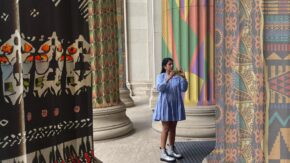 The Fovnders Pillars’ is an AR memorial that transforms the six neoclassical pillars of MIT’s iconic Building 10 into dynamic, living canvases, adorned with vibrant traditional African patterns. Each pillar represents one of the six African regions most impacted by the transatlantic slave trade: Mozambique, Angola, Nigeria, Ghana, Sierra Leone and Senegal. Collaborating with contemporary fabric designers and MIT students from these countries, we will create distinct designs for each pillar.
The Fovnders Pillars’ is an AR memorial that transforms the six neoclassical pillars of MIT’s iconic Building 10 into dynamic, living canvases, adorned with vibrant traditional African patterns. Each pillar represents one of the six African regions most impacted by the transatlantic slave trade: Mozambique, Angola, Nigeria, Ghana, Sierra Leone and Senegal. Collaborating with contemporary fabric designers and MIT students from these countries, we will create distinct designs for each pillar.During the AR experience, the audience will witness animated patterns from each fabric interact and merge to give birth to new designs, reflecting the strength of Pan African unity. This experience will be accompanied by a soundscape, shifting from individually composed sounds for each pillar and region to a blended composition that evolves alongside the new design created.
This installation stands as a powerful memorial to the six enslaved individuals once owned by MIT founder William Barton Rogers and pays tribute to the ancestral roots of the African American community from six different African regions. The project reclaims the space in remembrance and celebration of those lives, juxtaposing classical architecture with African artistry to confront the historical injustices intertwined with the institute’s legacy.
1. Create a portrait of 1 person from every possible age. Each person will be a member of the MIT Community. (Note: Portraits in this slide are from an earlier iteration.)
2. Augmented reality (AR) tools will be used to install this virtual portrait exhibition in the MIT Infinite Corridor. The viewing device will be the visitor’s smartphone.
3. Start in Lobby 7. Continue through buildings 3, 10, 4, and 8. Ascend stairs. Return through buildings 8, 4, 10, 3, and 7. End on Lobby 7 balcony and look up to the infinite.
4. Funding Needs: Produce portraits of over 100 members of the MIT community. Contract a Digital Experience Developer to customize and optimize AR installation.
